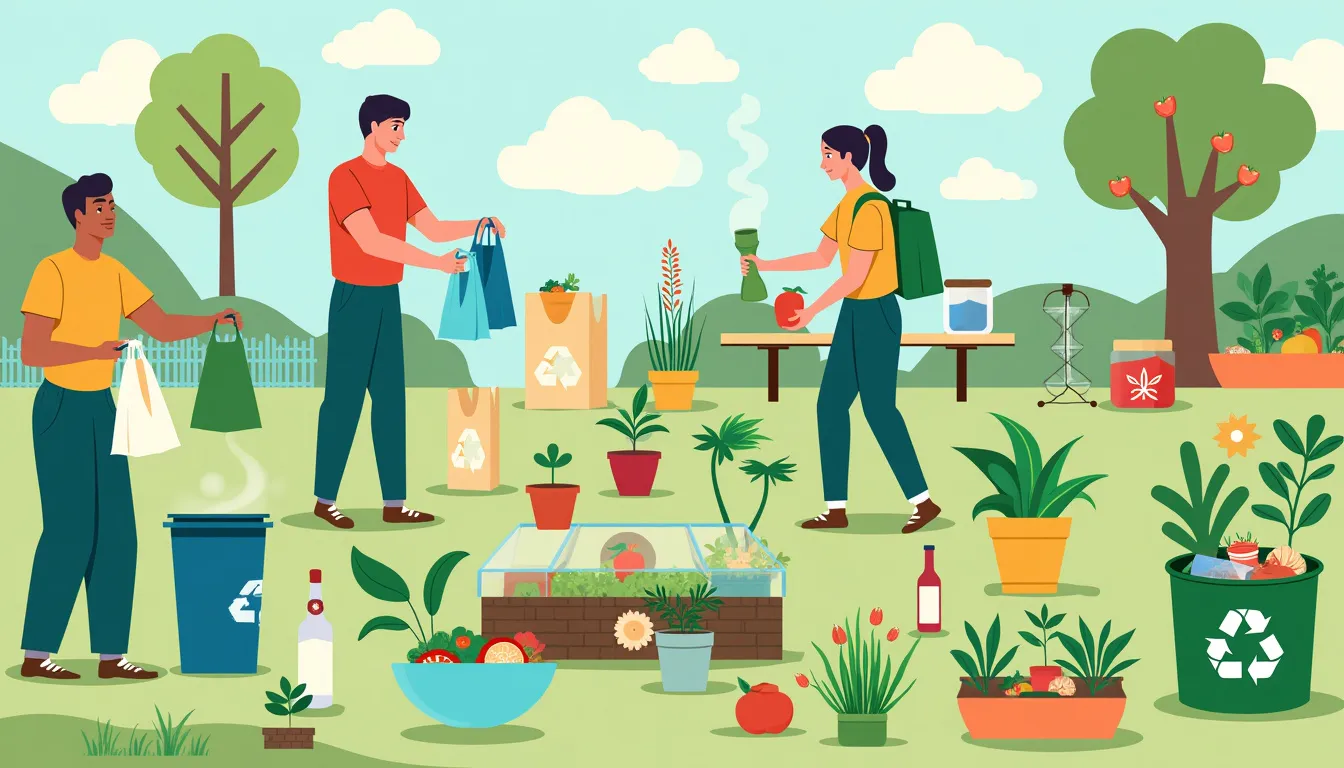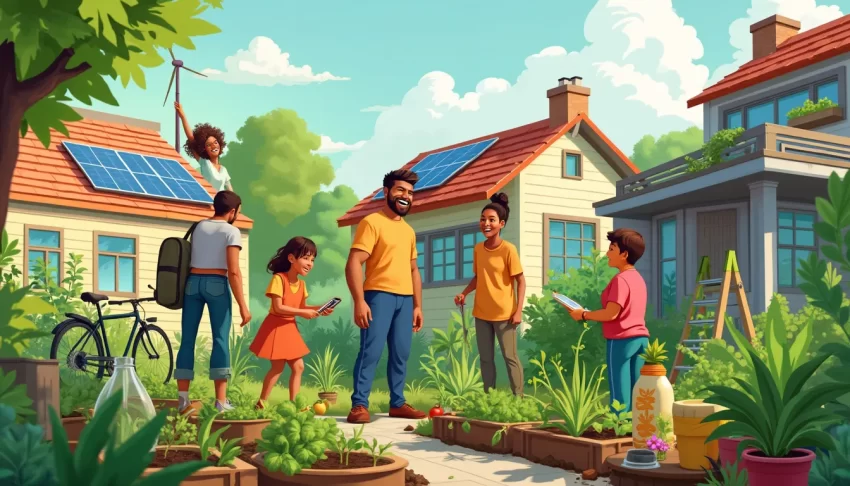Imagine a world where the air you breathe is cleaner, the water you drink is purer, and the food you eat is fresher. This is not just a distant dream but a reachable reality through the practice of sustainable living. Sustainable living, a lifestyle that seeks to reduce individual and collective impact on the environment, is more critical now than ever. With the growing evidence of climate change and environmental degradation, adopting a greener lifestyle has become an urgent necessity.
Sustainable living is not just about saving the planet; it’s about improving our quality of life in ways that are both profound and practical. It involves making conscious choices that promote environmental health, conserve resources, and support economic well-being. By making small, consistent changes in our daily habits, we can collectively make a significant difference. Whether it’s minimizing household waste, conserving energy, or making thoughtful food choices, everyone can contribute to a greener future.
The urgency to embrace sustainable living comes from the pressing environmental challenges we face today. Rising global temperatures, increasing sea levels, and the loss of biodiversity are just a few critical issues that demand immediate attention. By shifting to sustainable practices, we not only mitigate these problems but also build resilience against future ecological crises.
As you delve into this article, you’ll discover simple yet effective steps to incorporate sustainable living into your daily routine. From reducing waste and conserving energy at home to supporting local businesses and choosing green transportation options, these strategies are designed to be easily adoptable, whether you’re an individual looking to make a small impact or a business owner aspiring to lead by example. Let’s embark on this journey towards a greener future—one sustainable step at a time.
Definition and Importance of Sustainable Living
When we talk about sustainable living, we refer to a lifestyle that aims to reduce an individual’s or society’s use of Earth’s natural resources. Essentially, it means making thoughtful choices that ensure we meet our needs without compromising the ability of future generations to meet theirs. The principle lies in maintaining a balance—protecting our environment, ensuring social equity, and driving a thriving economy.
Sustainable living isn’t just a trendy buzzword; it’s a necessary shift in how we interact with our world. By adopting more sustainable practices, we can lessen our impact on the environment, reduce waste, and conserve vital resources. This lifestyle change plays a critical role in addressing pressing environmental issues such as climate change, pollution, and resource depletion.
The Urgency of Adopting a Greener Lifestyle
The urgency to adopt sustainable living practices has never been greater. The data is stark: the global temperature is rising at an unprecedented rate, with 2020 tying as the hottest year on record alongside 2016. This temperature increase is driven by human activities, particularly the burning of fossil fuels, deforestation, and industrial processes that emit greenhouse gases. If we continue on our current trajectory, we face more frequent extreme weather events, rising sea levels, and detrimental impacts on food security and human health.
In the face of these challenges, every small step towards sustainable living counts. Beyond the environmental impacts, there’s the economic aspect to consider. Unsustainable practices lead to resource scarcity, driving up costs and making it harder for individuals and businesses alike to operate efficiently. By shifting towards sustainable living, we not only help the environment but also pave the way for a more stable and resilient economy.
Take, for example, the simple shift from single-use plastics to reusable alternatives. On the surface, it might seem like a small change, but consider the broader impact. Over 8 million metric tons of plastic waste end up in our oceans annually, causing harm to marine life and disrupting ecosystems. By opting for reusable bags, containers, and bottles, we’re directly reducing that waste, conserving resources, and setting a positive example for others to follow.
Moreover, sustainable living fosters a greater sense of community and well-being. When we buy local products, support sustainable businesses, or participate in community-based projects, we build stronger, more connected communities. This, in turn, drives social cohesion and creates a supportive network where sustainable practices can thrive.
Understanding the importance and urgency of sustainable living is the first step towards making meaningful changes in our daily lives. The journey to a more sustainable lifestyle doesn’t require drastic overnight changes. Instead, it’s about making informed, conscious decisions that collectively make a significant impact. In the sections that follow, we’ll explore practical ways to incorporate sustainable living into your daily routine, ensuring that every action you take contributes to a greener future.

Simple Steps to Incorporate Sustainable Living into Daily Life
Reducing Waste
One of the most effective ways to start embracing sustainable living is by reducing waste. It’s remarkable how much of what we throw away can find a second life if we become more attentive and creative.
Practical Tips for Minimizing Household Waste
Consider the three Rs: Reduce, Reuse, and Recycle. By focusing on these principles, you can significantly minimize your household waste. Start by reducing your use of single-use plastics. Instead of plastic bags, opt for reusable cloth bags. Swap out plastic water bottles for stainless steel or glass ones. Buy in bulk to reduce packaging and consider DIY cleaning solutions that cut down on plastic containers.
Next, think about reusing. Old containers can be repurposed for storage, and worn-out clothing can be turned into cleaning rags. When it comes to children’s activities or home decor, upcycling can be both fun and sustainable.
Benefits of Recycling and Composting
Recycling is more than just separating paper from plastic; it’s about understanding and appreciating the lifecycle of your waste. Proper sorting can lead to substantial resource recovery, reducing the burden on landfills and the demand for raw materials.
Composting, on the other hand, turns organic waste into nutrient-rich soil additives, perfect for gardening. Composting not only drastically reduces the volume of your garbage but also cuts greenhouse gas emissions associated with landfill waste. Keep a small compost bin in your kitchen for food scraps, and you’ll be surprised at how little ends up in your trash.
Energy Conservation
Our homes are significant consumers of energy, which means they hold considerable potential for conservation. By incorporating some simple habits and making mindful choices, you can significantly reduce your energy footprint.
Easy Ways to Save Energy at Home
Simple measures can lead to substantial savings. Start by switching to LED or CFL lighting, which use a fraction of the electricity and have a notably longer lifespan. Consider investing in smart thermostats; they adapt to your schedule and manage heating and cooling more efficiently.
Unplug devices when not in use, as many electronics consume energy even when turned off. Wash clothes in cold water whenever possible and air-dry them to save on both heating and electricity. Insulating your home and sealing leaks can also reduce the need for excessive heating or cooling.
Switching to Renewable Energy Sources
For those ready to take a larger step, consider transitioning to renewable energy sources. Solar panels have become more affordable and efficient, capable of significantly reducing or even eliminating your electricity bill while powering your home sustainably. Wind and geothermal energy options are also worth exploring based on your location.
If installing renewable energy systems isn’t feasible, look into your electricity provider’s green energy programs. Many utility companies offer options to support renewable energy through your regular billing, allowing you to indirectly contribute to a greener grid.
Sustainable Food Choices
Food production and consumption have a profound impact on the environment. Making thoughtful food choices can lead to a more sustainable living practice.
Eating Locally and Seasonally
One straightforward way to make your diet more sustainable is to eat locally and seasonally. Local produce requires less transportation, resulting in reduced carbon emissions. Seasonal foods are often fresher and need fewer resources to grow.
Support local farmers’ markets, co-ops, and community-supported agriculture programs. Not only does this help the environment, but it also strengthens your local economy and ensures you consume fresh, high-quality foods.
Reducing Meat Consumption
Animal agriculture is a significant contributor to greenhouse gases and deforestation, making the reduction of meat consumption a powerful way to practice sustainable living. Consider adopting “Meatless Mondays” or try incorporating more plant-based meals throughout your week.
The production of plant-based foods generally requires less energy, water, and land than animal-based foods. Beans, lentils, vegetables, and grains are not only sustainable but also nutritious and budget-friendly alternatives.
By making these simple, yet impactful changes, you can set a powerful example and inspire others to join the journey towards sustainable living. Small actions taken collectively can pave the way to a greener, healthier future for all.

Sustainable Living in the Community
Supporting Local Businesses
One of the most impactful ways to embrace sustainable living is by supporting local businesses. Shopping local not only bolsters the local economy but also reduces the carbon footprint associated with transporting goods over long distances. Each local purchase leads to less fuel consumption and fewer greenhouse gas emissions.
Consider the story of Jane, a small-town florist who sources her flowers from nearby farms. By supporting Jane’s shop, her customers contribute to a sustainable supply chain that prioritizes local agriculture and minimizes transportation emissions. Furthermore, Jane’s business thrives, preserving jobs and promoting community well-being.
Moreover, local businesses often embrace sustainable practices themselves. Farmers’ markets are a prime example, offering fresh, seasonal produce with minimal packaging. This not only supports local agriculture but also helps reduce waste. When you buy from these markets, you’re participating in a circular economy that values environmental stewardship.
Community-Based Sustainability Initiatives
Communities across the globe are embracing sustainability through initiatives that promote environmental responsibility. From urban gardens to recycling programs, these grassroots efforts make a significant difference. For instance, community gardens provide a place for individuals to grow their own food, fostering a deeper connection to nature and reducing the need for mass-produced goods.
Take the example of the Green Thumb Program in New York City, which transforms vacant lots into lush gardens. These gardens not only beautify neighborhoods but also serve as educational hubs where residents learn about sustainable agriculture and composting. Participants experience firsthand the benefits of sustainable living while contributing to a healthier urban environment.
Green Transportation Options
Transportation is a major contributor to greenhouse gas emissions, but there are many ways to make your commute more eco-friendly. Embracing green transportation options helps mitigate the environmental impact and promotes sustainable urban development.
Benefits of Public Transport, Biking, and Walking
Public transportation is a cornerstone of sustainable living. Buses, trains, and subways can significantly reduce the number of vehicles on the road, lowering overall emissions. Cities like Copenhagen, which has an extensive public transport network, demonstrate how effective this can be. The city’s commitment to sustainability is evident in its clean air and reduced traffic congestion.
Biking and walking are excellent alternatives for shorter distances. Not only do they eliminate emissions, but they also offer health benefits. Amsterdam’s bike-friendly infrastructure has made biking a popular mode of transport, setting a global example of how cycling can integrate into daily life.
Consider implementing regular car-free days where you rely on biking or walking to get around. Communities around the world, including Bogotá, Colombia, participate in Ciclovía events where major streets are closed to motor vehicles, encouraging residents to cycle and walk. These events highlight the feasibility and benefits of reduced car usage.
Carpooling and Electric Vehicles
Carpooling is another effective strategy for reducing emissions. By sharing rides with others, we can cut down on the number of vehicles on the road and the amount of fuel consumed. Ride-sharing apps have made this easier than ever, connecting people with similar travel routes and promoting a culture of shared transport.
Electric vehicles (EVs) represent a revolutionary change in how we think about personal transport. While EVs still require energy, their overall environmental impact is significantly less than traditional gasoline-powered cars, especially when charged using renewable energy sources. Governments and companies worldwide are increasingly investing in EV infrastructure, making it more accessible for everyday use.
For example, Norway is leading the charge with its extensive network of EV charging stations and incentives for electric vehicle owners. As a result, more than half of all new cars sold in Norway are electric, showcasing a successful transition to a more sustainable transportation system.
Incorporating these green transportation options into your lifestyle not only aligns with the principles of sustainable living but also paves the way for healthier, more vibrant communities. By making conscious choices about how we shop and travel, we can collectively make a substantial positive impact on our environment.

Long-term Benefits of Sustainable Living
Positive Environmental Impact
Adopting a sustainable living approach has profound positive effects on the environment. One of the most significant impacts is the reduction of our carbon footprint and decrease in pollution. By making conscious choices like using renewable energy sources, reducing waste, and opting for green transportation, we can significantly lower the amount of greenhouse gases we emit. According to the Environmental Protection Agency (EPA), the average American household’s carbon footprint is around 48 metric tons of CO2 annually. Actions such as home energy conservation and reducing meat consumption can reduce this by nearly 50%.
Another critical advantage of sustainable living is the protection of biodiversity and natural resources. Our planet’s diverse ecosystems are delicate and increasingly under threat from human activities. For instance, deforestation for agriculture not only results in habitat loss but also contributes to approximately 15% of all greenhouse gas emissions each year (source: World Bank). By choosing sustainably sourced products and reducing our consumption, we can help preserve forests, oceans, and other natural habitats.
Consider the impact of a single-use plastic bottle. It can take over 450 years to decompose, during which it might release toxic chemicals into the soil and water, affecting various species. By using reusable bottles, you’re not only preventing pollution but also conserving the natural resources used in producing plastic bottles.
Personal Health and Financial Savings
Sustainable living doesn’t just benefit the environment; it also offers significant personal health advantages and financial savings. Let’s start with health. Many sustainable practices promote a healthier lifestyle. For instance, eating locally and seasonally often means fresher, less processed food that retains more nutrients. A diet rich in plant-based foods is linked to numerous health benefits, including reduced risks of heart disease, diabetes, and obesity. Moreover, reducing chemical exposure by choosing eco-friendly cleaning products and reducing air pollution through green transportation enhances overall well-being.
In terms of financial savings, sustainable living can be quite economical. Simple actions such as conserving energy at home by using LED bulbs and energy-efficient appliances can significantly reduce your utility bills. The Energy Star program estimates that households can save up to 30% on their energy bills by making these changes.
Additionally, embracing a minimalist lifestyle, which is a key aspect of sustainable living, encourages thoughtful consumption. By buying less and focusing on quality over quantity, you can save money while also reducing waste. For example, investing in a high-quality, durable wardrobe might cost more upfront but can save you money in the long run compared to frequently replacing cheaper, less durable clothing.
One inspiring example of cost savings through sustainability is the case of a family from California who decided to adopt a zero-waste lifestyle. Over a year, they managed to reduce their household waste to just one mason jar and saved over $2,000 by buying only what they needed, reusing and repurposing items, and making many of their cleaning and personal care products at home (TED Talks). Their story is a testament to how sustainable living leads to financial savings alongside environmental benefits.
Ultimately, sustainable living is more than a trend; it’s a vital shift towards ensuring a healthier planet and a higher quality of life for ourselves and future generations. By prioritizing sustainability, we pave the way for a greener, more prosperous future where both the environment and individuals thrive. So, why not start today? Simple adjustments in daily life can lead to long-term benefits that are both gratifying and essential.
As we navigate the complexities of modern life, embracing sustainable living isn’t just a moral choice but a necessary step towards a healthier, more resilient world. The urgency is clear: our planet’s resources are finite, and our current consumption patterns are unsustainable. By making small, deliberate changes in our daily routines, we can collectively create a significant positive impact.
Reducing household waste is a crucial first step. Simple actions like recycling, composting, and being mindful of our consumption can dramatically decrease the amount of waste we generate. These practices not only help minimize landfill overload but also conserve resources that would otherwise be used in producing new materials.
Energy conservation is another vital component of sustainable living. By adopting energy-saving habits—such as unplugging devices when not in use and utilizing energy-efficient appliances—we can reduce our carbon footprint and cut down on utility bills. Moreover, transitioning to renewable energy sources, like solar or wind power, further aligns our energy use with environmental sustainability goals.
Our food choices also play a significant role. Prioritizing local and seasonal foods supports local economies and reduces the environmental burden associated with long-distance transportation. Additionally, reducing meat consumption can lower greenhouse gas emissions and foster healthier eating habits.
Sustainable living extends beyond our homes into our communities. Supporting local businesses keeps the economic cycle robust and limits the environmental impact of transporting goods over long distances. Participating in or initiating community-based sustainability projects can amplify individual efforts, turning small actions into broader movements.
Additionally, embracing green transportation options can revolutionize our daily commutes and travel habits. Integrating more walking, cycling, and public transit into our routines reduces traffic congestion and air pollution. For those who drive, carpooling or investing in electric vehicles can make a substantial difference.
The long-term benefits of these sustainable practices are profound. Environmentally, they contribute to reducing carbon emissions and pollution, thereby protecting our planet’s biodiversity and conserving natural resources. Personally, sustainable living can lead to improved health outcomes and substantial financial savings through reduced consumption and energy use.
By committing to sustainable living, we are not only fostering a cleaner, healthier planet but also enhancing our well-being and community resilience. Every small step counts, and collectively, our actions can pave the way for a greener future. So, let’s take these steps together—our planet and future generations will thank us for it.
Support Us: Check out our recommended products on Amazon.

